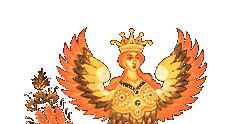Palekh and the Palekh Museum
Depending on road conditions, the kind of car you're in, and who's behind the wheel, the village of Palekh is 5-6 hours outside of Moscow. We took our trip to the three villages of Palekh, Kholuy, and Mstera beginning on a Sunday. We decided to take the road that leads first to Palekh, then continues on to Kholuy, which was to be our home for the next few days. Mstera we would reach coming around on another road, then back into Moscow. Here's a map showing the three villages. Since it was March, the roads were in pretty bad condition--the melting snows take their toll on the asphalt, plus there were patches of highway that were grazed for re-tarring, but were laying fallow like the snow-covered fields to either side. But even a mediocre Russian driver would have no real difficulty negotiating the potholes, dips, bumps, and the other cars and trucks on the road. He knows what his vehicle can handle and exactly how big it is to squeeze into the narrowest of gaps in traffic.
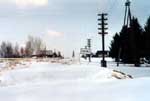 We arrived in Palekh in early afternoon, stopped in a few places, then made our way to Kholuy for the night. The first part of the next day was spent in Kholuy, but the rest of Monday we were in Palekh. This seemed like the historic place where the progenitors of modern-day lacquer art resided. The first stop was the Palekh Museum, but fate had other ideas. Monday is the vykhodnoy dyen, or day off, for the museum and the bookstore. We tried the doors, but no one was around. So instead we began visiting the artists we had planned to meet.
Our mission in the villages was three-fold--acquaint me with the villages and visit the museums, meet with certain artists to order and pick up boxes, and to collect biographies and photographs of artists not yet in our online database. I felt as though we achieved all three of those goals. Two of the artists we visited were the Gurilyevs, husband and wife duo Sergey and Marina. They were extremely nice and very welcoming of our visit. We climbed the stairs up to the sunny and inviting loft where these two masters create their highly detailed and highly sought-after miniatures. They have two tables that face each other so that they can both paint at the same time. With the pictures I took of each of them behind their work space, I tried to capture first the youth of Maria because her other pictures made her seem aged, and also their collective work space--the little bottles of pigment on the wall, the arm rest, the brushes, lamps, and magnifying glasses. Sergey and Maria showed us a few works in progress as well as photographs of many of their pieces. Then they offered to show us their greatest 'work' to date--their sleeping baby!
We arrived in Palekh in early afternoon, stopped in a few places, then made our way to Kholuy for the night. The first part of the next day was spent in Kholuy, but the rest of Monday we were in Palekh. This seemed like the historic place where the progenitors of modern-day lacquer art resided. The first stop was the Palekh Museum, but fate had other ideas. Monday is the vykhodnoy dyen, or day off, for the museum and the bookstore. We tried the doors, but no one was around. So instead we began visiting the artists we had planned to meet.
Our mission in the villages was three-fold--acquaint me with the villages and visit the museums, meet with certain artists to order and pick up boxes, and to collect biographies and photographs of artists not yet in our online database. I felt as though we achieved all three of those goals. Two of the artists we visited were the Gurilyevs, husband and wife duo Sergey and Marina. They were extremely nice and very welcoming of our visit. We climbed the stairs up to the sunny and inviting loft where these two masters create their highly detailed and highly sought-after miniatures. They have two tables that face each other so that they can both paint at the same time. With the pictures I took of each of them behind their work space, I tried to capture first the youth of Maria because her other pictures made her seem aged, and also their collective work space--the little bottles of pigment on the wall, the arm rest, the brushes, lamps, and magnifying glasses. Sergey and Maria showed us a few works in progress as well as photographs of many of their pieces. Then they offered to show us their greatest 'work' to date--their sleeping baby!
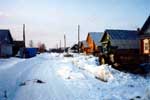 Another husband and wife pair that I was very impressed with was the young Kurkins. Alexander is the youngest of three generations of living Palekh artists; his grandfather is Alexander Mikhailovich Kurkin, and his father is Boris Alexandrovich Kurkin. Natasha also comes from a family of well-known artists--her father is Alexander Shemarov. They too have a 'great work', perhaps the next generation lacquer artist in the Kurkin family. If their son's craftsmanship turns out to be anything like his parents, then he will be a great artist indeed! Alexander Kurkin already has a few pieces in the Palekh Museum and has participated in several exhibitions. We ordered a large box from him that is sure to be stunning!
Another husband and wife pair that I was very impressed with was the young Kurkins. Alexander is the youngest of three generations of living Palekh artists; his grandfather is Alexander Mikhailovich Kurkin, and his father is Boris Alexandrovich Kurkin. Natasha also comes from a family of well-known artists--her father is Alexander Shemarov. They too have a 'great work', perhaps the next generation lacquer artist in the Kurkin family. If their son's craftsmanship turns out to be anything like his parents, then he will be a great artist indeed! Alexander Kurkin already has a few pieces in the Palekh Museum and has participated in several exhibitions. We ordered a large box from him that is sure to be stunning!
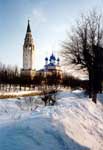 After visiting a few other artists, including the rising star Zhenya Shatokhina, we headed back to Kholuy for the night. Tuesday was our last day in the villages, and we had planned to spend most of the day in Mstera. However we didn't want to miss the Palekh Museum. So we drove back to Palekh the next morning and were almost disappointed again! Although the sign said that the museum should be open, the doors were locked. So we went to the next building over where the bookstore and gift shop are located, and the girls cleaning the lobby said that today everything was closed--vykhodnoy dyen. She was surprised when we showed her that it said Monday was the vykhodnoy on the metal plaque affixed to the door. "Well, Tuesday is the big market day, so you probably won't see the lady that runs everything" was her only reply.
After visiting a few other artists, including the rising star Zhenya Shatokhina, we headed back to Kholuy for the night. Tuesday was our last day in the villages, and we had planned to spend most of the day in Mstera. However we didn't want to miss the Palekh Museum. So we drove back to Palekh the next morning and were almost disappointed again! Although the sign said that the museum should be open, the doors were locked. So we went to the next building over where the bookstore and gift shop are located, and the girls cleaning the lobby said that today everything was closed--vykhodnoy dyen. She was surprised when we showed her that it said Monday was the vykhodnoy on the metal plaque affixed to the door. "Well, Tuesday is the big market day, so you probably won't see the lady that runs everything" was her only reply.
 We decided to wait it out and went down the street to look at Ivan Golikov's house. Preserved in its original state, his residence is now a museum (which by the way was also closed). From that corner of the street there is a nice view of the small Palekh cathedral, with its aging bell tower but newly painted cupolas. As we were walking back to the car debating how long we were going to wait, we saw the cleaning girl again who said that the bookstore operator was on her way down. This was good news because there were several new catalogs that we wanted to buy for reference purposes. With that success, we headed over to the museum.
We decided to wait it out and went down the street to look at Ivan Golikov's house. Preserved in its original state, his residence is now a museum (which by the way was also closed). From that corner of the street there is a nice view of the small Palekh cathedral, with its aging bell tower but newly painted cupolas. As we were walking back to the car debating how long we were going to wait, we saw the cleaning girl again who said that the bookstore operator was on her way down. This was good news because there were several new catalogs that we wanted to buy for reference purposes. With that success, we headed over to the museum.
  Having paid our entry fee, plus a photo pass (just like at the Kremlin, only more!), we started gazing at the treasures in the museum. Centuries-old icons, Ivan Golikov boxes, enormous plaques, gorgeous boxes, and even a set of tables and chairs (painted by the two older Kurkins).
Having paid our entry fee, plus a photo pass (just like at the Kremlin, only more!), we started gazing at the treasures in the museum. Centuries-old icons, Ivan Golikov boxes, enormous plaques, gorgeous boxes, and even a set of tables and chairs (painted by the two older Kurkins).
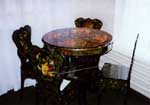  As far as village museums went, this was probably the nicest--wooden cabinets with clear glass, good lighting, and nice carpets. The two floors and many separate rooms were also reminiscent of much larger art museums like the Tretyakov. Only this one specialized in one thing--incredible samples of Palekh art like nowhere else.
As far as village museums went, this was probably the nicest--wooden cabinets with clear glass, good lighting, and nice carpets. The two floors and many separate rooms were also reminiscent of much larger art museums like the Tretyakov. Only this one specialized in one thing--incredible samples of Palekh art like nowhere else.
 Click here for the next selection from the trip
Click here for the next selection from the trip
|

